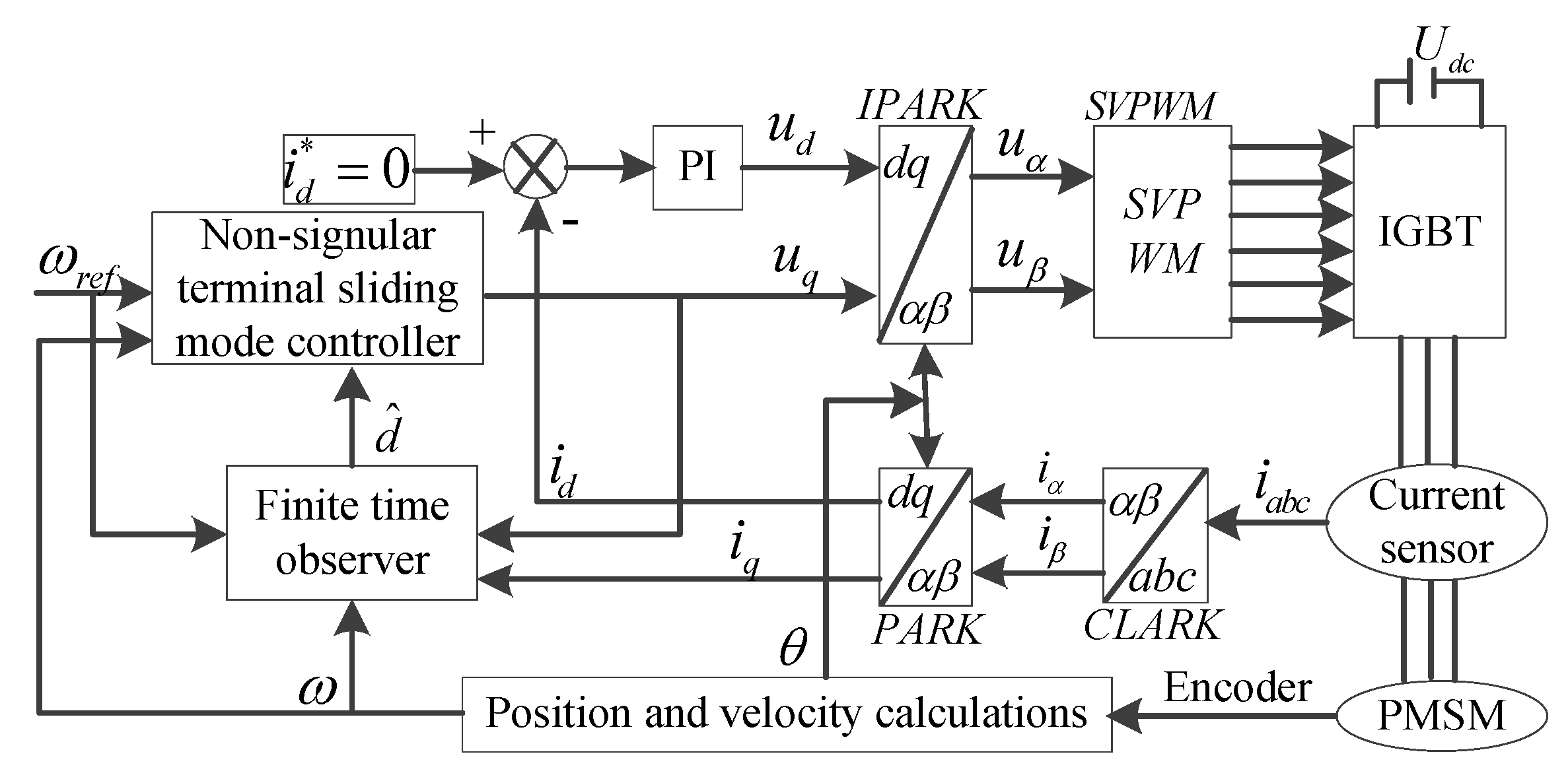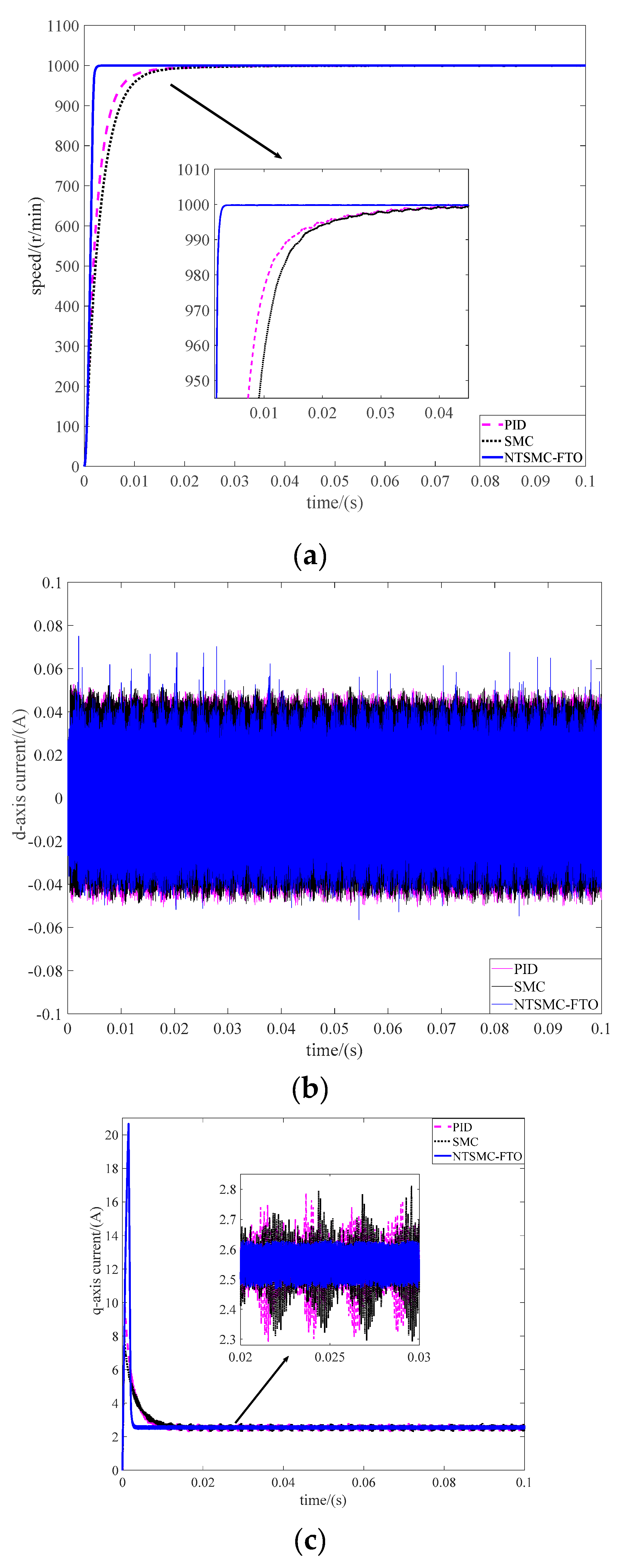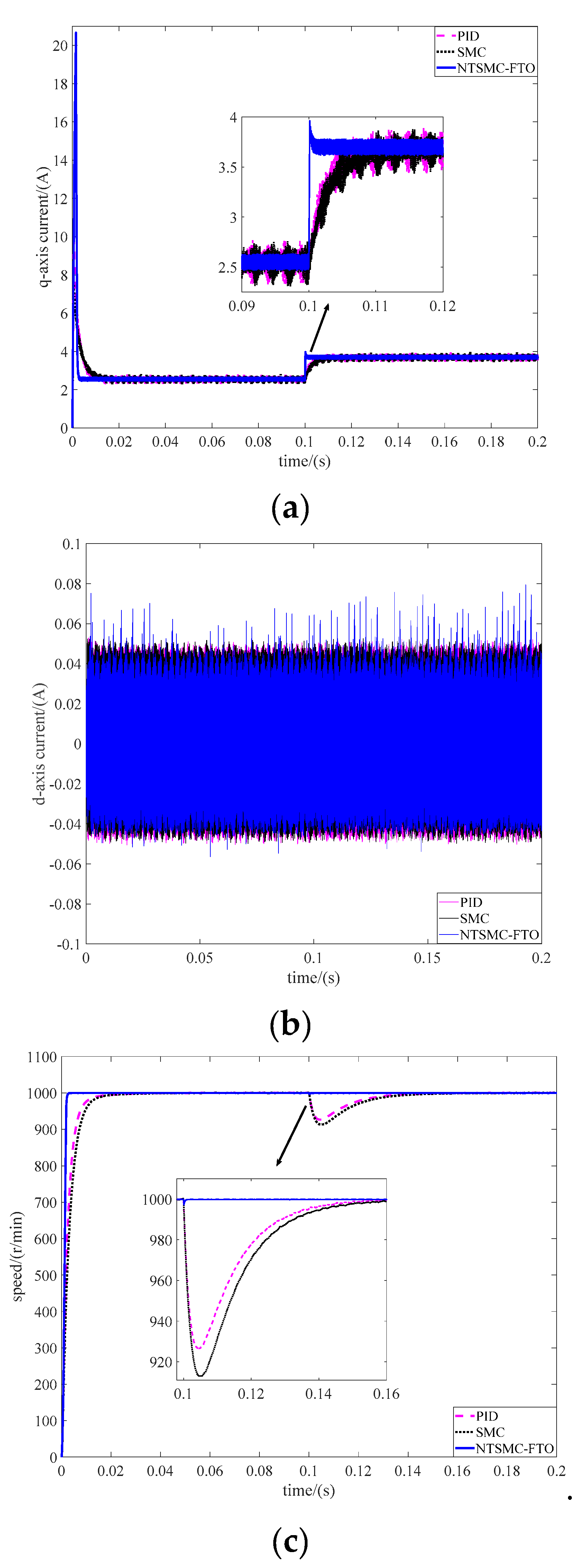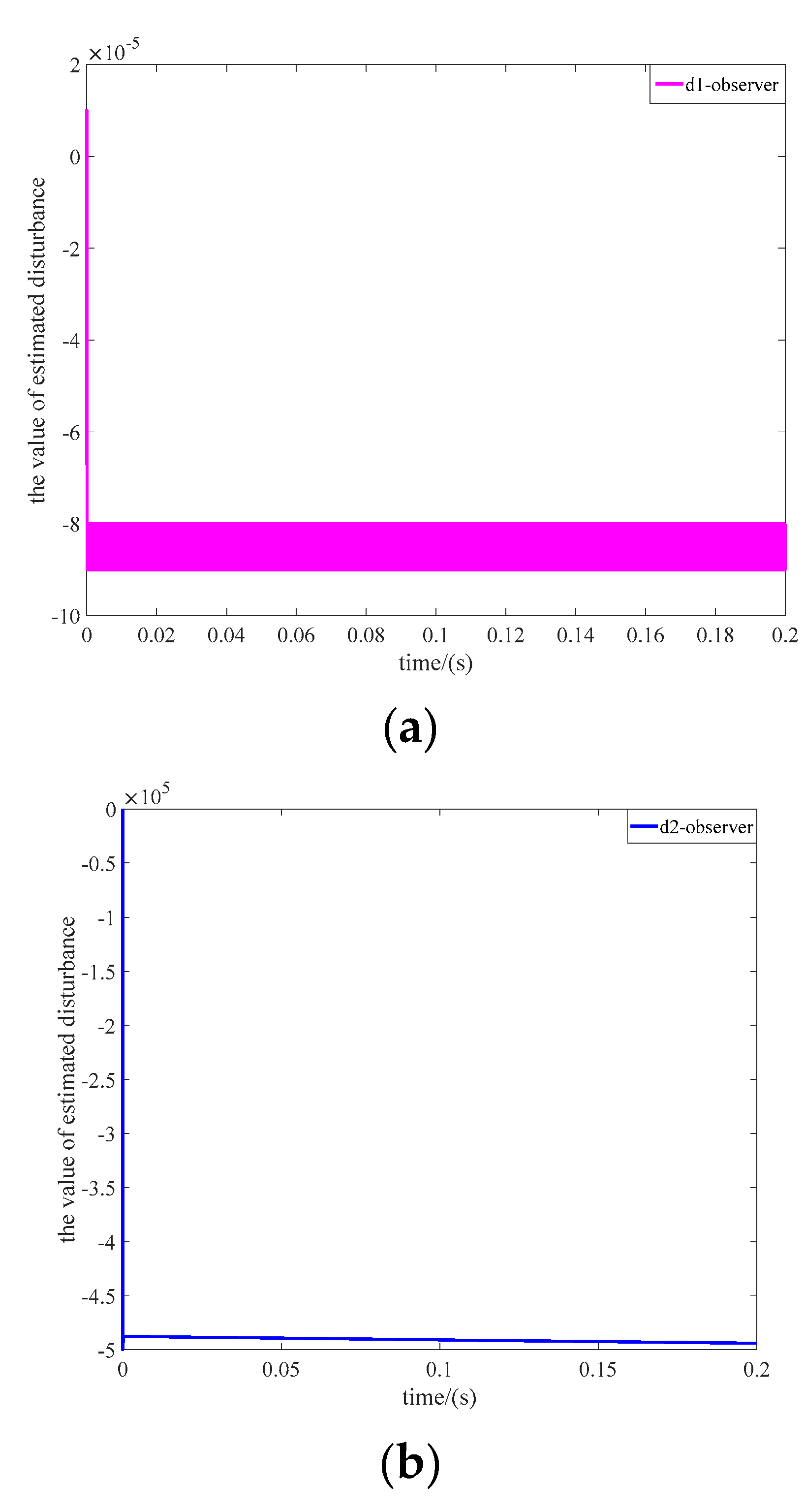The Direct Speed Control of Pmsm Based on Terminal Sliding Mode and Finite Time Observer
Abstract
1. Introduction
2. Preliminaries
2.1. The Mathematical Model of Pmsm
2.2. The Mathematic Model of Speed-Current Single-Loop
3. Control Design
3.1. Finite Time Observer
3.2. Non-Singular Terminal Sliding Mode Control
4. Simulation and Analysis
5. Conclusions
Author Contributions
Funding
Acknowledgments
Conflicts of Interest
References
- Lara, J.; Xu, J.; Chandra, A. Effects of Rotor Position Error in the Performance of Field Oriented Controlled PMSM Drives for Electric Vehicle Traction Applications. IEEE Trans. Ind. Electron. 2016, 63, 1. [Google Scholar] [CrossRef]
- Kommuri, S.K.; Defoort, M.; Karimi, H.R.; Veluvolu, K.C. A Robust Observer-Based Sensor Fault-Tolerant Control for PMSM in Electric Vehicles. IEEE Trans. Ind. Electron. 2016, 63, 7671–7681. [Google Scholar] [CrossRef]
- Liu, H.X.; Li, S.H. Speed control for PMSM servo system using predictive functional control and extended state observer. IEEE Trans. Ind. Electron. 2012, 59, 1171–1183. [Google Scholar] [CrossRef]
- Chaoui, H.; Khayamy, M.; Aljarboua, A.A. Adaptive Interval Type-2 Fuzzy Logic Control for PMSM Drives with a Modified Reference Frame. IEEE Trans. Ind. Electron. 2017, 64, 3786–3797. [Google Scholar] [CrossRef]
- Valente, G.; Formentini, A.; Papini, L.; Gerada, C.; Zanchetta, P. Performance improvement of bearingless multisector PMSM with optimal robust position control. IEEE Trans. Power Electron. 2019, 34, 3575–3585. [Google Scholar] [CrossRef]
- Sun, Z.X.; Li, S.H.; Wang, J.G.; Zhang, X.H.; Mo, X.H. Adaptive composite control method of permanent magnet synchronous motor systems. Trans. Inst. Meas. Control 2018, 11, 3345–3357. [Google Scholar] [CrossRef]
- Yu, J.; Shi, P.; Zhao, L. Finite-time command filtered backstepping control for a class of nonlinear systems. Automatica 2018, 92, 173–180. [Google Scholar] [CrossRef]
- Liang, W.; Fei, W.; Luk, P.C.-K. An Improved Sideband Current Harmonic Model of Interior PMSM Drive by Considering Magnetic Saturation and Cross-Coupling Effects. IEEE Trans. Ind. Electron. 2016, 63, 4097–4104. [Google Scholar] [CrossRef]
- Ren, H.P.; Liu, D. Nonlinear feedback control of chaos in permanent magnet synchronous motor. IEEE Trans. Circuits Syst. II Express Briefs 2016, 53, 45–50. [Google Scholar]
- Formentini, A.; Trentin, A.; Marchesoni, M.; Zanchetta, P.; Wheeler, P. Speed Finite Control Set Model Predictive Control of a PMSM Fed by Matrix Converter. IEEE Trans. Ind. Electron. 2015, 62, 6786–6796. [Google Scholar] [CrossRef]
- Cheema, M.A.M.; Fletcher, J.E.; Farshadnia, M.; Xiao, D.; Rahman, M.F. Combined Speed and Direct Thrust Force Control of Linear Permanent-Magnet Synchronous Motors with Sensorless Speed Estimation Using a Sliding-Mode Control with Integral Action. IEEE Trans. Ind. Electron. 2017, 64, 3489–3501. [Google Scholar] [CrossRef]
- Lang, X.Y.; Yang, M.; Xu, H.D.; Long, J.; Xu, D.G. A non-cascade predictive speed and current controller with PWM modulation for PMSM. In Proceedings of the IECON 2016-42nd Annual Conference of the IEEE Industrial Electronics Society, Florence, Italy, 23–26 October 2016. [Google Scholar]
- Guo, T.L.; Sun, Z.X.; Wang, X.Y.; Li, S.H.; Zhang, K.J. A simple current-constrained controller for permanent-magnet synchronous motor. IEEE Trans. Ind. Inform. 2019, 15, 1486–1495. [Google Scholar] [CrossRef]
- Yan, Y.; Yang, J.; Sun, Z.; Zhang, C.; Li, S.; Yu, H. Robust Speed Regulation for PMSM Servo System with Multiple Sources of Disturbances via an Augmented Disturbance Observer. IEEE/ASME Trans. Mechatron. 2018, 23, 769–780. [Google Scholar] [CrossRef]
- Liu, X.; Yu, H.; Yu, J.; Zhao, L. Combined Speed and Current Terminal Sliding Mode Control with Nonlinear Disturbance Observer for PMSM Drive. IEEE Access 2018, 6, 29594–29601. [Google Scholar] [CrossRef]
- Chaoui, H.; Khayamy, M.; Okoye, O. Adaptive RBF network based direct voltage control for interior PMSM based vehicles. IEEE Trans. Veh. Technol. 2018, 67, 5740–5749. [Google Scholar] [CrossRef]
- Zhang, X.G.; He, Y.K. Direct voltage-selection based model predictive direct speed control for PMSM drives without weighting factor. IEEE Trans. Power Electron. 2019, 34, 7838–7851. [Google Scholar] [CrossRef]
- Preindl, M.; Bolognani, S. Model predictive direct speed control with finite control set of PMSM drive systems. IEEE Trans. Power Electron. 2013, 28, 1007–1015. [Google Scholar] [CrossRef]
- Smidl, V.; Janous, S.; Adam, L.; Peroutka, Z. Direct Speed Control of a PMSM Drive Using SDRE and Convex Constrained Optimization. IEEE Trans. Ind. Electron. 2018, 65, 532–542. [Google Scholar] [CrossRef]
- Liu, B.; Zhou, B.; Ni, T.H. Principle and stability analysis of an improved self-sensing control strategy for surface-mounted PMSM drives using second-order generalized integrators. IEEE Trans. Energy Convers. 2018, 33, 126–136. [Google Scholar] [CrossRef]
- Mynar, Z.; Veselý, L.; Vaclavek, P. PMSM Model Predictive Control with Field-Weakening Implementation. IEEE Trans. Ind. Electron. 2016, 63, 5156–5166. [Google Scholar] [CrossRef]
- Liu, J.; Li, H.W.; Deng, Y.T. Torque ripple minimization of PMSM based on robust ILC via adaptive sliding mode control. IEEE Trans. Power Electron. 2018, 33, 3655–3671. [Google Scholar] [CrossRef]
- Tarczewski, T.; Grzesiak, L.M. Constrained state feedback speed control of PMSM based on model predictive approach. IEEE Trans. Ind. Electron. 2016, 63, 3867–3875. [Google Scholar] [CrossRef]
- Wang, W.-C.; Liu, T.-H.; Syaifudin, Y. Model Predictive Controller for a Micro-PMSM-Based Five-Finger Control System. IEEE Trans. Ind. Electron. 2016, 63, 3666–3676. [Google Scholar] [CrossRef]
- Xia, C.; Li, S.; Shi, Y.; Zhang, X.; Sun, Z.; Yin, W. A Non-Smooth Composite Control Approach for Direct Torque Control of Permanent Magnet Synchronous Machines. IEEE Access 2019, 7, 45313–45321. [Google Scholar] [CrossRef]
- Zhang, G.Q.; Wang, G.L.; Yuan, B.H. Active disturbance rejection control strategy for signal injection-based sensorless IPMSM drives. IEEE Trans. Transp. Electrif. 2018, 1, 330–339. [Google Scholar] [CrossRef]
- Li, S.H.; Zhou, M.M.; Yu, X.H. Design and Implementation of terminal sliding mode control method for PMSM speed regulation system. IEEE Trans. Ind. Inform. 2013, 9, 1879–1891. [Google Scholar] [CrossRef]
- Li, S.H.; Wu, C.; Sun, Z.X. Design and implementation of clutch control for automotive transmissions using terminal-sliding-mode control and uncertainty observer. IEEE Trans. Veh. Technol. 2016, 65, 1890–1898. [Google Scholar] [CrossRef]
- Du, H.B.; Chen, X.P.; Wen, G.H.; Yu, X.H.; Lü, J.H. Discrete-time fast terminal sliding mode control for permanent magnet linear motor. IEEE Trans. Ind. Electron. 2018, 65, 9916–9927. [Google Scholar] [CrossRef]
- Wu, F.; Li, P.; Wang, J. FO improved fast terminal sliding mode control method for permanent-magnet synchronous motor with FO disturbance observer. IET Control. Theory Appl. 2019, 13, 1425–1434. [Google Scholar] [CrossRef]
- Xu, W.; Junejo, A.K.; Liu, Y.; Islam, M.R. Improved Continuous Fast Terminal Sliding Mode Control with Extended State Observer for Speed Regulation of PMSM Drive System. IEEE Trans. Veh. Technol. 2019, in press. [Google Scholar] [CrossRef]
- Guo, L.; Wang, D.; Diao, L.; Peng, Z. Direct voltage control of stand-alone DFIG under asymmetric loads based on non-singular terminal sliding mode control and improved extended state observer. IET Electr. Power Appl. 2019, 13, 958–968. [Google Scholar] [CrossRef]
- He, L.; Wang, F.; Wang, J.; Rodriguez, J. Zynq Implemented Lunenberger Disturbance Observer Based Predictive Control Scheme for PMSM Drives. IEEE Trans. Power Electron. 2019, in press. [Google Scholar] [CrossRef]
- Yang, J.; Cui, H.Y.; Li, S.H.; Zolotas, A. Optimized active disturbance rejection control for DC-DC buck converters with uncertainties using a reduced-order GPI observer. IEEE Trans. Circuits Syst. I Regul. Pap. 2018, 65, 832–841. [Google Scholar] [CrossRef]
- An, H.; Liu, J.X.; Wang, C.H.; Wu, L.G. Disturbance observer-based anti-windup control for air-breathing hypersonic vehicles. IEEE Trans. Ind. Electron. 2016, 63, 3038–3049. [Google Scholar] [CrossRef]
- Hebertt, S.R.; Jesús, L.F.; Carlos, G.R.; Marco, A.C.O. On the control of the permanent magnet synchronous motor: An active disturbance rejection control approach. IEEE Trans. Control Syst. Technol. 2014, 22, 2056–2063. [Google Scholar]
- Chen, W.-H. Disturbance Observer Based Control for Nonlinear Systems. IEEE/ASME Trans. Mechatron. 2004, 9, 706–710. [Google Scholar] [CrossRef]
- Chen, M.-S.; Chen, C.-C. Robust Nonlinear Observer for Lipschitz Nonlinear Systems Subject to Disturbances. IEEE Trans. Autom. Control. 2007, 52, 2365–2369. [Google Scholar] [CrossRef]
- Khalil, H. Nonlinear Systems, 2nd ed.; Prentice-Hall: Upper Saddle River, NJ, USA, 1996. [Google Scholar]
- Hong, Y.; Huang, J.; Xu, Y. On an output feedback finite-time stabilization problem. IEEE Trans. Autom. Control 2001, 46, 305–309. [Google Scholar] [CrossRef]
- Shen, Y.J.; Huang, Y.H. Uniformly observable and globally Lipschitzian nonlinear systems admit global finite-time observers. IEEE Trans. Autom. Control 2009, 54, 2621–2625. [Google Scholar] [CrossRef]
- Perruquetti, W.; Floquet, T.; Moulay, E. Finite-Time Observers: Application to Secure Communication. IEEE Trans. Autom. Control. 2008, 53, 356–360. [Google Scholar] [CrossRef]
- Du, H.B.; Qian, C.J.; Yang, S.Z.; Li, S.H. Recursive design of finite time convergent observers for a class of time varying nonlinear systems. Automatica 2013, 49, 601–609. [Google Scholar] [CrossRef]
- Davila, J.; Fridman, L.; Levant, A. Second-order sliding-mode observer for mechanical systems. IEEE Trans. Autom. Control. 2005, 50, 1785–1789. [Google Scholar] [CrossRef]
- Lin, C.-K. Nonsingular Terminal Sliding Mode Control of Robot Manipulators Using Fuzzy Wavelet Networks. IEEE Trans. Fuzzy Syst. 2006, 14, 849–859. [Google Scholar] [CrossRef]




| Rated Power | PN | 200 | W |
|---|---|---|---|
| line resistance | R | 0.33 | Ω |
| line inductance | L | 9 × 10−4 | H |
| magnetic poles | np | 4 | pairs |
| torque constant | Kt | 0.087 | N·m/A |
| rated power | UN | 36 | VAC |
| rated current | IN | 7.5 | A |
| rotor inertia | J | 1.89 × 10−5 | kg·m2 |
| rated speed | nN | 3000 | r/min |
| Description | Parameter | Value |
|---|---|---|
| speed loop proportional gain | K1 | 0.01 |
| speed loop integral gain | I1 | 0.95 |
| speed loop proportional gain | K2 | 50 |
| speed loop integral gain | I2 | 100,000 |
| current loop Id proportional | Kp1 | 2000 |
| current loop Id integral gain | KI1 | 100,000 |
| Description | Parameter | Value |
|---|---|---|
| error gain of SMC | c | 10.8 |
| switch gain of SMC | Mu | 100 |
| sliding mode surface gain of SMC | 12 | |
| speed loop proportional gain | K2 | 50 |
| speed loop integral gain | I2 | 100,000 |
| current loop Id proportional | Kp1 | 2000 |
| current loop Id integral gain | KI1 | 10,000 |
| Description | Parameter | Value |
|---|---|---|
| the power of NTSMC | p | 37 |
| the power of NTSMC | q | 35 |
| proportional gain of NTSMC | 5100 | |
| switch gain of NTSMC | 200,000,000,000 | |
| the gain of observer1 | 1,000,000 | |
| the gain of observer1 | 10 | |
| the gain of observer2 | 50,000,000 | |
| the gain of observer2 | 500 | |
| current loop proportional | Kp1 | 2000 |
| current loop integral gain | KI1 | 10,000 |
| Method | Reference Speed | Time to Reach Steady State |
|---|---|---|
| NTSMC-FTO | 1000 r/min | 0.0028 s |
| the cascade SMC | 1000 r/min | 0.045 s |
| the cascade PID | 1000 r/min | 0.045 s |
| Method | Reference Speed | Decreased Value of Speed | The Recover Time of Steady State |
|---|---|---|---|
| NTSMC-FTO | 1000 r/min | 2.5 r/min | 0.0004 s |
| the cascade SMC | 1000 r/min | 87 r/min | 0.06 s |
| the cascade PID | 1000 r/min | 74 r/min | 0.06 s |
© 2019 by the authors. Licensee MDPI, Basel, Switzerland. This article is an open access article distributed under the terms and conditions of the Creative Commons Attribution (CC BY) license (http://creativecommons.org/licenses/by/4.0/).
Share and Cite
Wang, Y.; Yu, H.; Che, Z.; Wang, Y.; Liu, Y. The Direct Speed Control of Pmsm Based on Terminal Sliding Mode and Finite Time Observer. Processes 2019, 7, 624. https://doi.org/10.3390/pr7090624
Wang Y, Yu H, Che Z, Wang Y, Liu Y. The Direct Speed Control of Pmsm Based on Terminal Sliding Mode and Finite Time Observer. Processes. 2019; 7(9):624. https://doi.org/10.3390/pr7090624
Chicago/Turabian StyleWang, Yao, HaiTao Yu, Zhiyuan Che, Yuchen Wang, and Yulei Liu. 2019. "The Direct Speed Control of Pmsm Based on Terminal Sliding Mode and Finite Time Observer" Processes 7, no. 9: 624. https://doi.org/10.3390/pr7090624
APA StyleWang, Y., Yu, H., Che, Z., Wang, Y., & Liu, Y. (2019). The Direct Speed Control of Pmsm Based on Terminal Sliding Mode and Finite Time Observer. Processes, 7(9), 624. https://doi.org/10.3390/pr7090624






